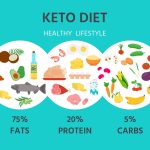The CCHO diet, short for Carb-Cycle High-Protein/Omega-3 diet, is an eating plan designed to optimize fat loss and muscle gain by cycling between periods of high and low carbohydrate intake. This approach aims to balance macronutrients for enhanced metabolic function and muscle recovery. In this comprehensive guide, we will explore the CCHO diet, its benefits, guidelines, and a detailed food list to help you get started.
What is the CCHO Diet?
The CCHO diet combines elements of carb cycling with high-protein and omega-3 fatty acids to improve body composition and overall health. Carb cycling involves alternating between high-carb and low-carb days to manage insulin sensitivity and fuel workouts. The high-protein component helps in muscle repair and growth, while omega-3 fatty acids support heart health and reduce inflammation.
Benefits of the CCHO Diet
- Enhanced Muscle Growth: High protein intake helps repair and build muscle tissue, making it beneficial for those engaging in strength training or bodybuilding.
- Improved Fat Loss: Carb cycling helps regulate insulin levels and promotes fat burning while preserving lean muscle mass.
- Increased Energy Levels: By strategically timing carbohydrate intake, the CCHO diet provides sustained energy throughout the day.
- Better Metabolic Flexibility: Alternating between high and low-carb days can improve the body’s ability to use both carbohydrates and fats for energy.
- Reduced Inflammation: Omega-3 fatty acids have anti-inflammatory properties that support overall health and recovery.
CCHO Diet Guidelines
- Carb Cycling:
- High-Carb Days: Typically 1-2 days per week, focusing on complex carbs like whole grains, fruits, and vegetables.
- Low-Carb Days: The rest of the week, emphasizing protein and healthy fats with minimal carbohydrate intake.
- Protein Intake: Aim for high-quality protein sources, including lean meats, fish, eggs, and plant-based proteins. The general recommendation is to consume 1.2-2.2 grams of protein per kilogram of body weight.
- Omega-3 Fatty Acids: Include sources rich in omega-3s, such as fatty fish, flaxseeds, and walnuts. Aim for at least 1-2 servings of omega-3-rich foods daily.
- Hydration: Drink plenty of water to stay hydrated and support overall metabolic function.
- Meal Timing: Align your carb intake with your workout schedule to maximize energy and recovery. Consume carbs before or after exercise on high-carb days.
CCHO Diet Food List
High-Carb Days
- Whole Grains: Brown rice, quinoa, oats, barley, and whole wheat products.
- Fruits: Apples, berries, bananas, oranges, and melons.
- Vegetables: Sweet potatoes, broccoli, spinach, carrots, and bell peppers.
- Legumes: Lentils, chickpeas, black beans, and kidney beans.
- Dairy: Low-fat yogurt and milk.
Low-Carb Days
- Protein Sources: Chicken breast, turkey, lean beef, tofu, tempeh, and fish.
- Healthy Fats: Avocado, olive oil, coconut oil, and nuts.
- Non-Starchy Vegetables: Leafy greens, cucumbers, zucchini, asparagus, and cauliflower.
- Eggs: Whole eggs or egg whites.
- Cheese: Hard cheeses like cheddar or Swiss (in moderation).
Sample Meal Plan
High-Carb Day:
- Breakfast: Oatmeal topped with berries and a side of scrambled eggs.
- Lunch: Quinoa salad with mixed vegetables and a piece of grilled chicken.
- Snack: Greek yogurt with honey and a banana.
- Dinner: Brown rice stir-fry with vegetables and tofu.
Low-Carb Day:
- Breakfast: Spinach and mushroom omelet with avocado slices.
- Lunch: Grilled salmon with a side of steamed broccoli.
- Snack: A handful of almonds.
- Dinner: Chicken breast with a large salad of leafy greens and olive oil dressing.
FAQs About the CCHO Diet
Q1: How does carb cycling benefit the CCHO diet?
A1: Carb cycling helps manage insulin levels and promotes fat loss while providing energy for workouts. It allows for periods of higher carb intake to fuel exercise and lower carb days to encourage fat burning.
Q2: Can I follow the CCHO diet if I am vegetarian or vegan?
A2: Yes, you can adapt the CCHO diet for a vegetarian or vegan lifestyle by choosing plant-based protein sources like tofu, tempeh, legumes, and plant-based protein powders, and focusing on vegan-friendly omega-3 sources like flaxseeds and walnuts.
Q3: How do omega-3 fatty acids fit into the CCHO diet?
A3: Omega-3 fatty acids are included in the CCHO diet to reduce inflammation and support overall health. They are essential for recovery and can be obtained from sources like fatty fish, flaxseeds, and walnuts.
Q4: How long should I follow the CCHO diet?
A4: The CCHO diet can be followed long-term if it suits your health goals and lifestyle. It’s important to monitor your progress and make adjustments as needed.
Q5: What are some common challenges with the CCHO diet?
A5: Challenges may include managing meal timing and portion sizes, ensuring adequate nutrient intake, and staying consistent with carb cycling. Proper planning and meal prep can help address these challenges.
Q6: Can I use supplements while on the CCHO diet?
A6: Supplements can be used to support your diet, such as protein powders or omega-3 supplements. However, it’s best to consult with a healthcare professional before adding supplements to your routine.
Q7: How do I adjust the CCHO diet for weight loss?
A7: To promote weight loss, focus on creating a caloric deficit by adjusting portion sizes and meal frequency. Monitor your progress and make gradual changes to your diet as needed.
Q8: What are the signs that the CCHO diet is working?
A8: Signs that the CCHO diet is effective include improved muscle definition, increased energy levels, better recovery from workouts, and gradual fat loss.
Conclusion
The CCHO diet offers a structured approach to balancing carbohydrates, protein, and omega-3 fatty acids for optimal fat loss and muscle growth. By following the guidelines and incorporating a variety of nutrient-dense foods, you can achieve your fitness goals and support overall health. Experiment with different meal plans and adjustments to find the best approach for your individual needs.











